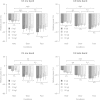Modulation of event-related desynchronization during kinematic and kinetic hand movements
- PMID: 24886610
- PMCID: PMC4077682
- DOI: 10.1186/1743-0003-11-90
Modulation of event-related desynchronization during kinematic and kinetic hand movements
Abstract
Background: Event-related desynchronization/synchronization (ERD/ERS) is a relative power decrease/increase of electroencephalogram (EEG) in a specific frequency band during physical motor execution and mental motor imagery, thus it is widely used for the brain-computer interface (BCI) purpose. However what the ERD really reflects and its frequency band specific role have not been agreed and are under investigation. Understanding the underlying mechanism which causes a significant ERD would be crucial to improve the reliability of the ERD-based BCI. We systematically investigated the relationship between conditions of actual repetitive hand movements and resulting ERD.
Methods: Eleven healthy young participants were asked to close/open their right hand repetitively at three different speeds (Hold, 1/3 Hz, and 1 Hz) and four distinct motor loads (0, 2, 10, and 15 kgf). In each condition, participants repeated 20 experimental trials, each of which consisted of rest (8-10 s), preparation (1 s) and task (6 s) periods. Under the Hold condition, participants were instructed to keep clenching their hand (i.e., isometric contraction) during the task period. Throughout the experiment, EEG signals were recorded from left and right motor areas for offline data analysis. We obtained time courses of EEG power spectrum to discuss the modulation of mu and beta-ERD/ERS due to the task conditions.
Results: We confirmed salient mu-ERD (8-13 Hz) and slightly weak beta-ERD (14-30 Hz) on both hemispheres during repetitive hand grasping movements. According to a 3 × 4 ANOVA (speed × motor load), both mu and beta-ERD during the task period were significantly weakened under the Hold condition, whereas no significant difference in the kinetics levels and interaction effect was observed.
Conclusions: This study investigates the effect of changes in kinematics and kinetics on resulting ERD during repetitive hand grasping movements. The experimental results suggest that the strength of ERD may reflect the time differentiation of hand postures in motor planning process or the variation of proprioception resulting from hand movements, rather than the motor command generated in the down stream, which recruits a group of motor neurons.
Figures




Similar articles
-
A brain-computer interface driven by imagining different force loads on a single hand: an online feasibility study.J Neuroeng Rehabil. 2017 Sep 11;14(1):93. doi: 10.1186/s12984-017-0307-1. J Neuroeng Rehabil. 2017. PMID: 28893295 Free PMC article.
-
Ipsilateral EEG mu rhythm reflects the excitability of uncrossed pathways projecting to shoulder muscles.J Neuroeng Rehabil. 2017 Aug 25;14(1):85. doi: 10.1186/s12984-017-0294-2. J Neuroeng Rehabil. 2017. PMID: 28841920 Free PMC article.
-
Muscle-selective disinhibition of corticomotor representations using a motor imagery-based brain-computer interface.Neuroimage. 2018 Dec;183:597-605. doi: 10.1016/j.neuroimage.2018.08.070. Epub 2018 Aug 30. Neuroimage. 2018. PMID: 30172003
-
ERD/ERS patterns reflecting sensorimotor activation and deactivation.Prog Brain Res. 2006;159:211-22. doi: 10.1016/S0079-6123(06)59014-4. Prog Brain Res. 2006. PMID: 17071233 Review.
-
[Discrimination between left and right hand movement imagery event-releated EEG pattern].Sheng Wu Yi Xue Gong Cheng Xue Za Zhi. 2004 Dec;21(6):1031-4. Sheng Wu Yi Xue Gong Cheng Xue Za Zhi. 2004. PMID: 15646359 Review. Chinese.
Cited by
-
Neural Mass Modeling in the Cortical Motor Area and the Mechanism of Alpha Rhythm Changes.Sensors (Basel). 2024 Dec 25;25(1):56. doi: 10.3390/s25010056. Sensors (Basel). 2024. PMID: 39796846 Free PMC article.
-
Exploiting the heightened phase synchrony in patients with neuromuscular disease for the establishment of efficient motor imagery BCIs.J Neuroeng Rehabil. 2018 Oct 29;15(1):90. doi: 10.1186/s12984-018-0431-6. J Neuroeng Rehabil. 2018. PMID: 30373619 Free PMC article. Clinical Trial.
-
Brain-movement relationship during upper-limb functional movements in chronic post-stroke patients.J Neuroeng Rehabil. 2024 Oct 22;21(1):188. doi: 10.1186/s12984-024-01461-3. J Neuroeng Rehabil. 2024. PMID: 39438994 Free PMC article.
-
Brain Processes Involved in Motor Planning Are a Dominant Factor for Inducing Event-Related Desynchronization.Front Hum Neurosci. 2021 Nov 11;15:764281. doi: 10.3389/fnhum.2021.764281. eCollection 2021. Front Hum Neurosci. 2021. PMID: 34858156 Free PMC article.
-
Collective almost synchronization-based model to extract and predict features of EEG signals.Sci Rep. 2020 Oct 1;10(1):16342. doi: 10.1038/s41598-020-73346-z. Sci Rep. 2020. PMID: 33004963 Free PMC article.
References
-
- Shindo K, Kawashima K, Ushiba J, Ota N, Ito M, Ota T, Kimura A, Liu M. Effects of neurofeedback training with an electroencephalogram- based brain-computer interface for hand paralysis in patients with chronic stroke: a preliminary case series study. J Rehabil Med. 2011;43(10):951–957. - PubMed
-
- Hayashi Y, Nagai K, Ito K, Nasuto SJ, Loureiro RCV, Harwin WS. Proceedings of the 4th IEEE RAS and EMBS International Conference on Biomedical Robotics and Biomechatronics. Rome, Italy; 2012. A feasible study of EEG-driven assistive robotic system for stroke rehabilitation; pp. 1733–1739.
Publication types
MeSH terms
LinkOut - more resources
Full Text Sources
Other Literature Sources
Research Materials

